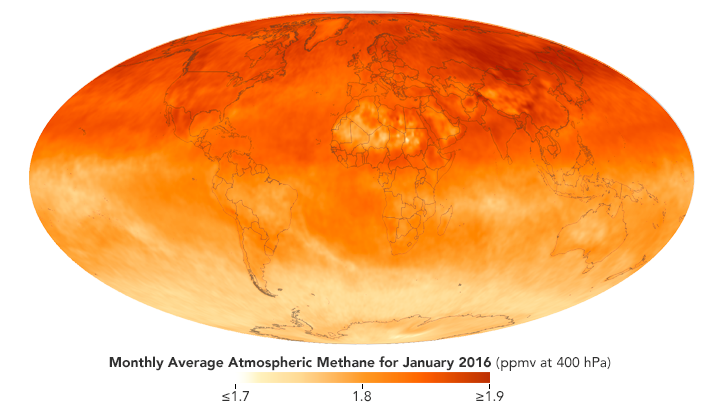NASA study underscores urgency of solving the global methane problem
A new NASA study suggests methane emissions from fossil fuels may be responsible for half of the recent rise in global atmospheric methane concentrations. While we’ve known for some time that methane levels have been increasing worldwide, it hasn’t been clear why. The research narrows uncertainty as to both the sources and trends influencing global methane emissions.
According to the study, which was published last week in the journal Nature Communications, methane emissions from fossil fuels are rising at a rate of 12 to 19 million metric tons a year.
Different interpretations of global methane concentration data have attributed fluctuating methane levels to a wide variety of sources and factors, including fossil fuel production, increased emissions from agriculture and changing wetlands, or the rate of methane removed from the atmosphere.
This new NASA study, however, suggests methane levels are increasing and the primary drivers are emissions from fossil fuels, including oil, gas and coal, along with biogenic sources (e.g., wetlands and cattle).
Science in Context
Using satellite imagery, scientists from NASA, NCAR (National Center for Atmospheric Research), and SRON (Netherlands Institute for Space Research) observed lower and declining methane emissions from wildfires – a decrease happening twice as fast as previous studies have shown. With improved data, researchers now estimate emissions from other sources such as oil and gas to be rising faster than expected.
The revelation comes as multiple studies point to higher than reported emissions of methane, a powerful greenhouse gas, associated with oil and gas activity.
One study from researchers at Carleton University found that oil and gas methane emissions in Alberta, the “Texas of Canada”, are at least 25 to 50 percent higher than current estimates. Another NASA study identified a 2500-square mile methane hot spot over the four corners region of New Mexico, Colorado, Utah and Arizona. Subsequent research verified nearby oil and gas emissions as the key source.
Advancing Global Methane Science
A growing number of leading global oil and gas companies including BP, Exxon and Shell have embraced methane reductions as a priority, while others have pledged to a near zero methane emissions future. Access to more and better data is essential for industry and policy makers worldwide to track progress and improve the efficiency of reductions that are achievable today.
It’s why EDF is participating in a series of independent investigator lead scientific studies through UN environment to measure global oil and gas methane emissions. The new work builds on EDF’s multi-year research effort in the United States, which helped to fill important knowledge gaps and to improve field practices as well as inform government policies.
Leveraging breakthroughs in technology to further expand our understanding is another key. For example, one of our latest endeavors – a partnership with the Netherlands Institute for Space Research (SRON) – involves tracking atmospheric methane from an orbiting satellite. Data from this satellite is expected to help enhance transparency of these emissions for industry and governments.
Grabbing the Lowest-hanging Fruit
Oil and gas methane is a significant global problem, but it is also a problem with a relatively simple solution. The International Energy Agency singled out methane as a central business issue for oil and gas companies, concluding that the industry can reduce its worldwide emissions by 75 percent – and that up to two thirds of those reductions can be realized at zero net cost. Further, IEA says that just the no net cost reductions would have the same climate impact in 2100 as immediately closing all the coal plants in China.
A key takeaway from this latest NASA study is that methane levels are climbing worldwide and fossil fuel production plays a big role. At the same time, we know that massive reductions across the global oil and gas industry are highly feasible – and also impactful. So, even as better data will lead to more informed decisions for both companies and countries looking to reduce their greenhouse gases that include methane, there are large-scale, low-hanging fruit opportunities that can and should be pursued now.
Image source: NASA












